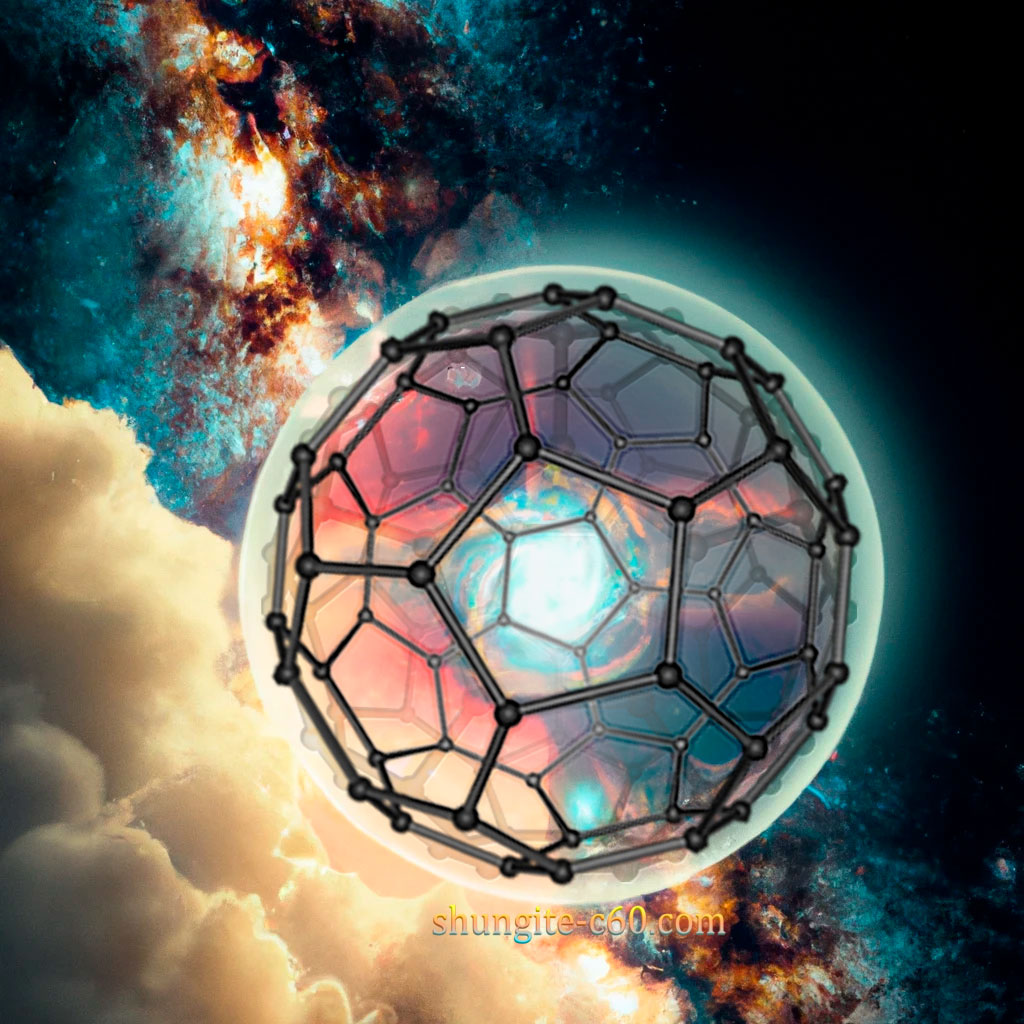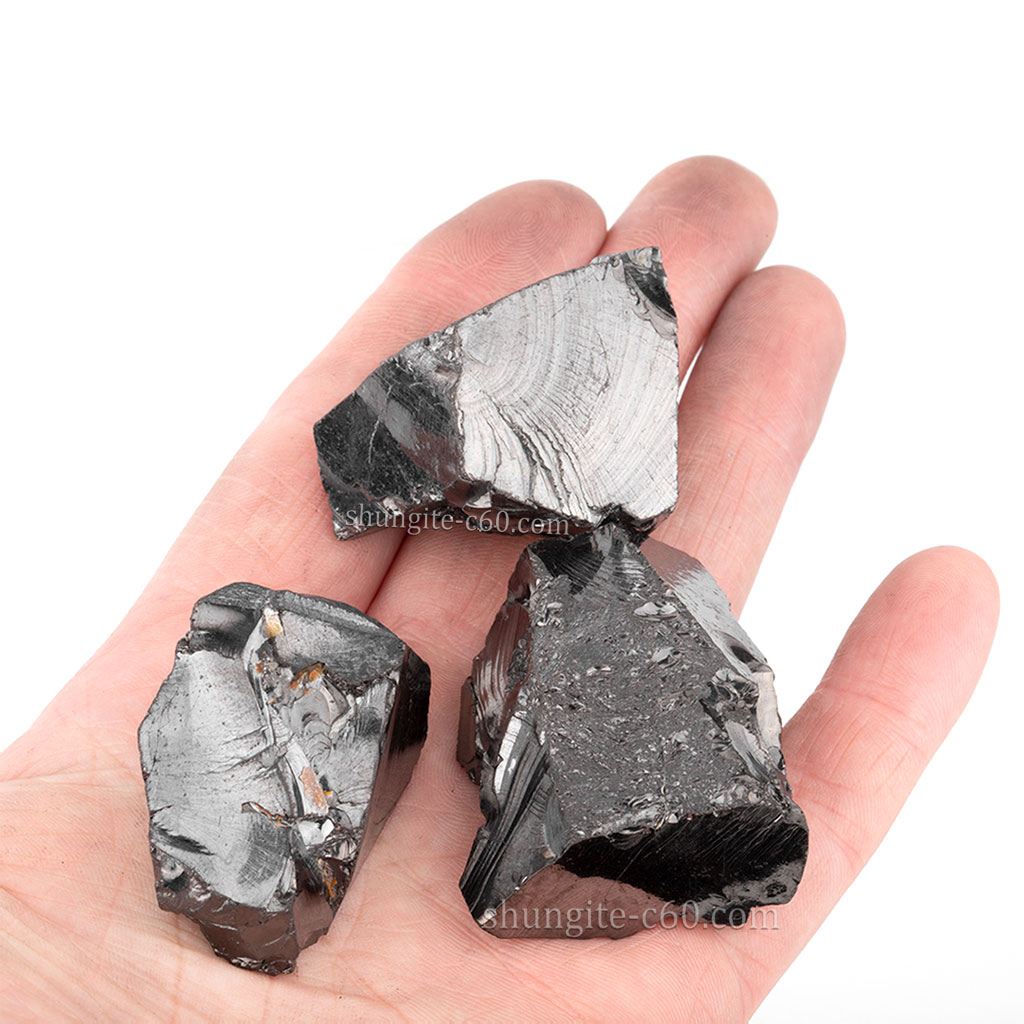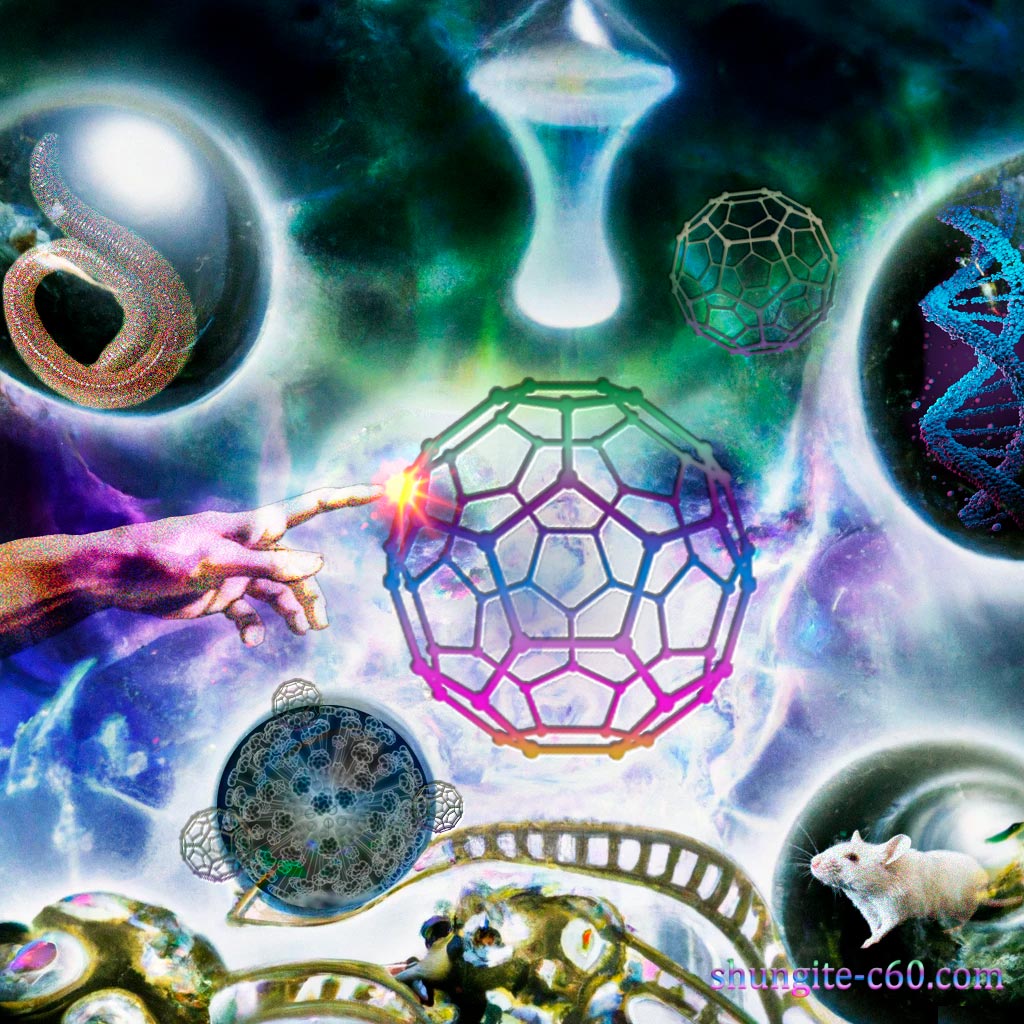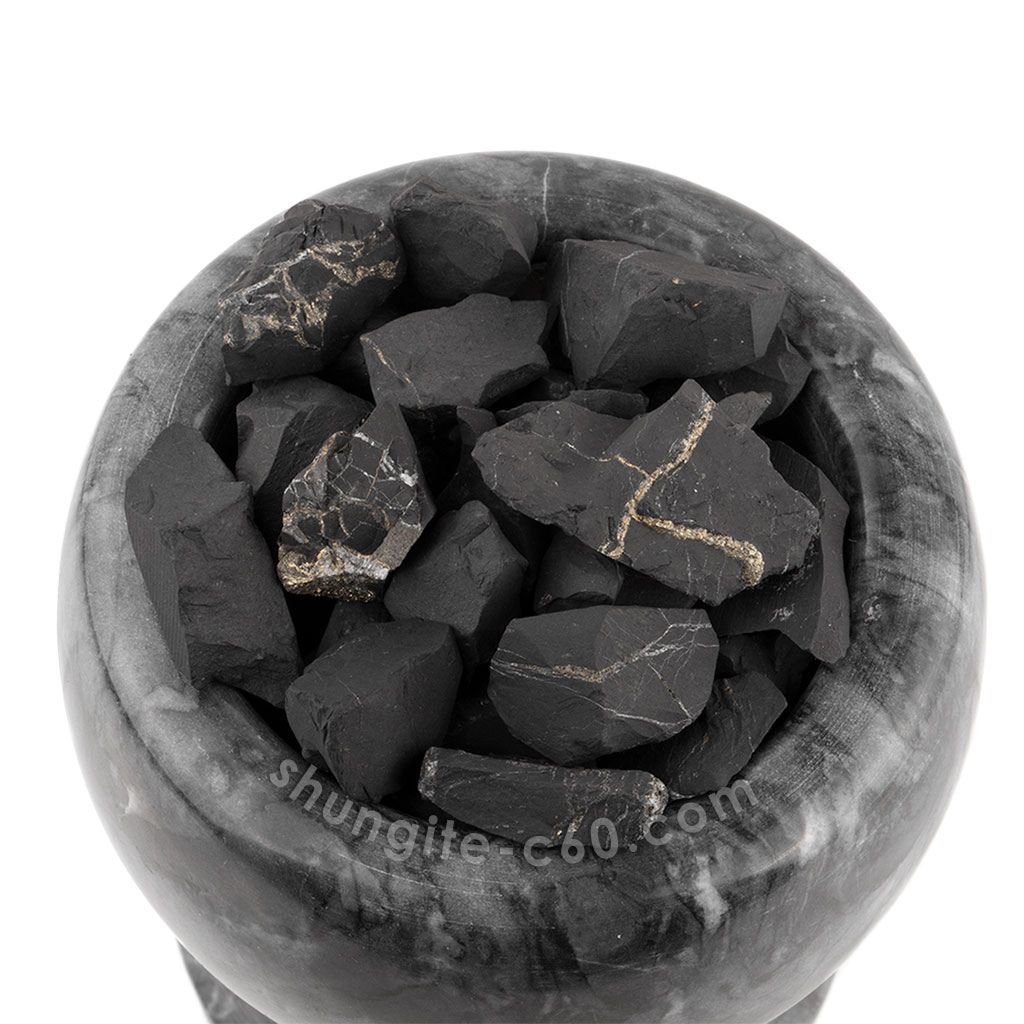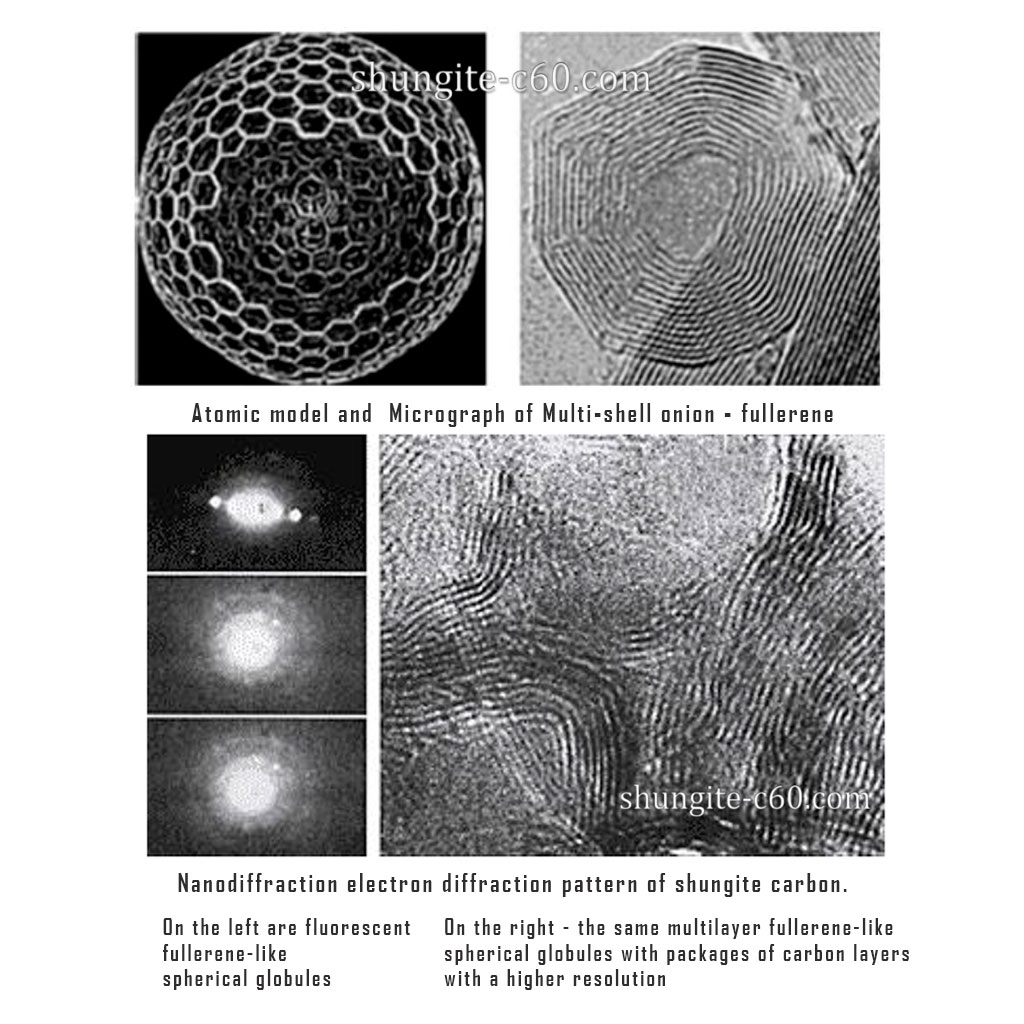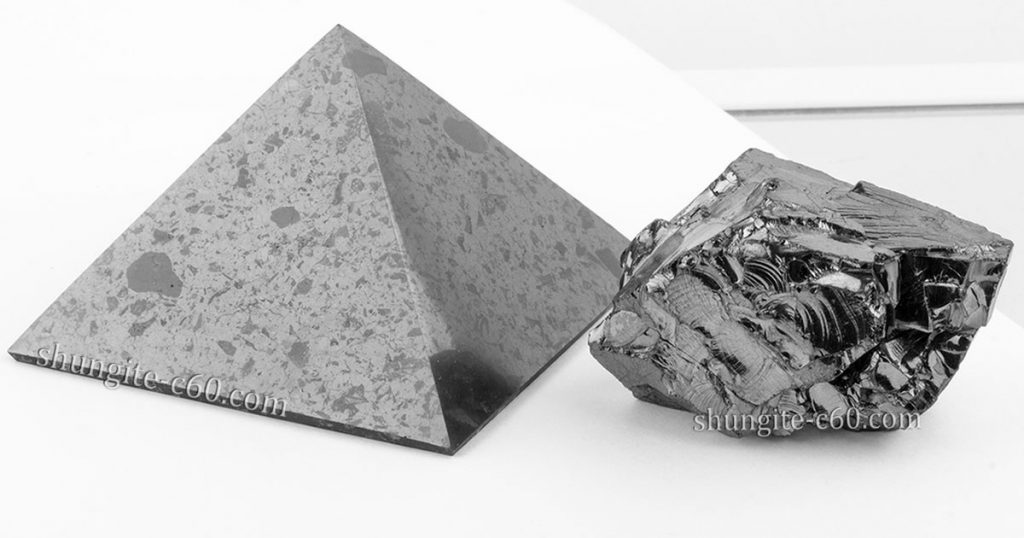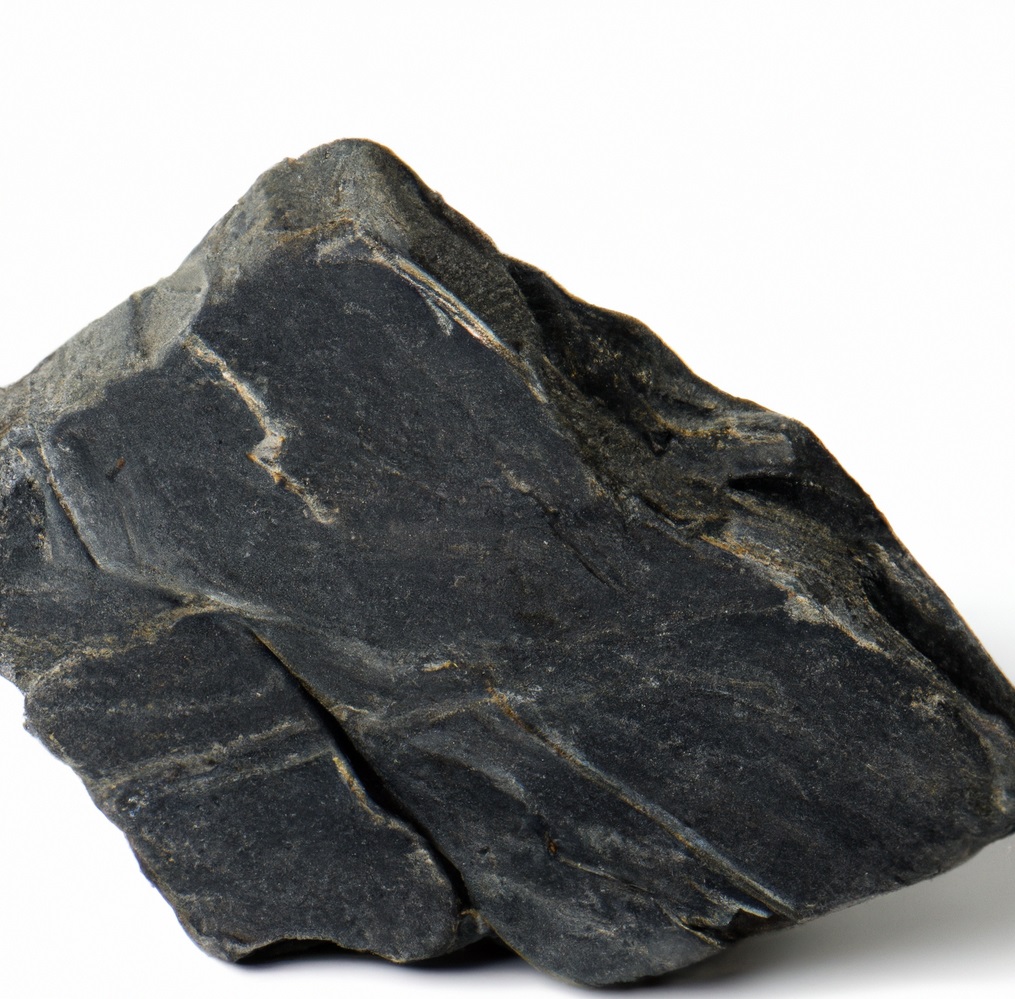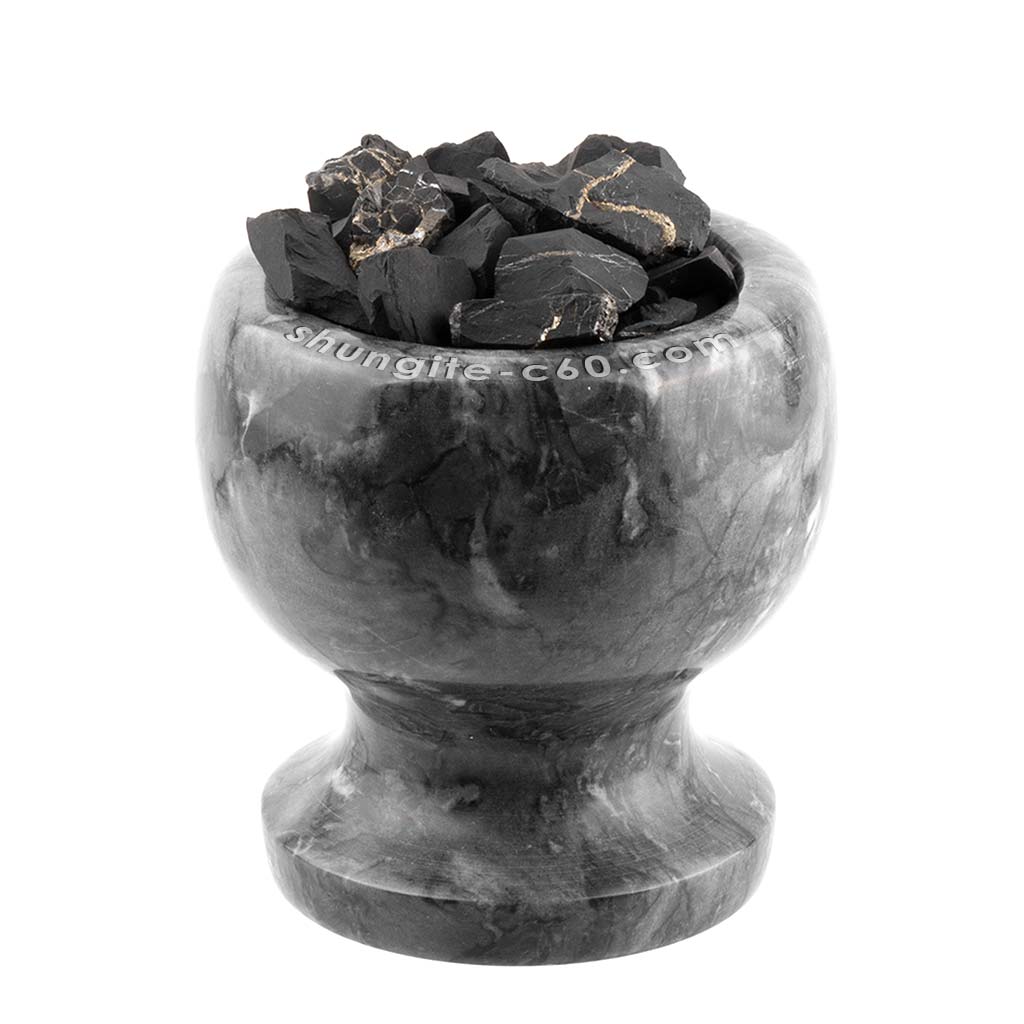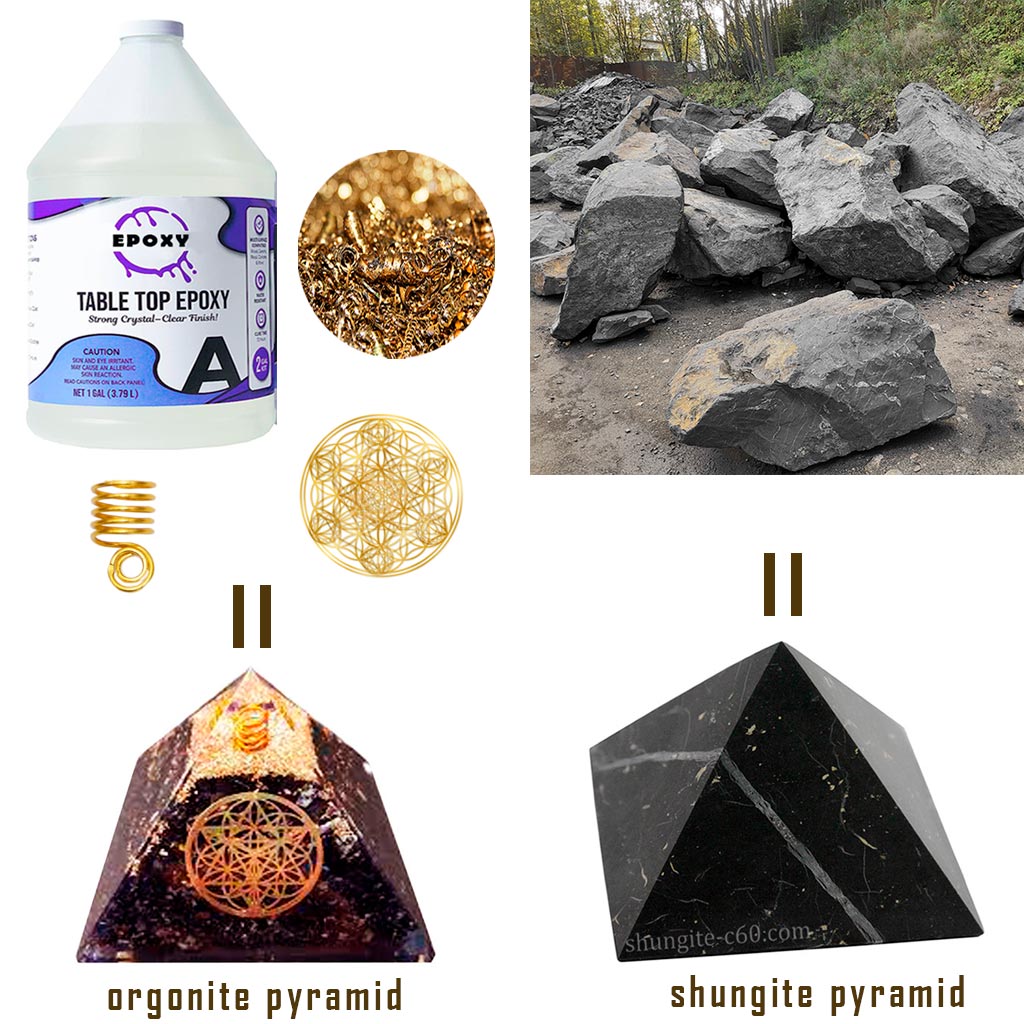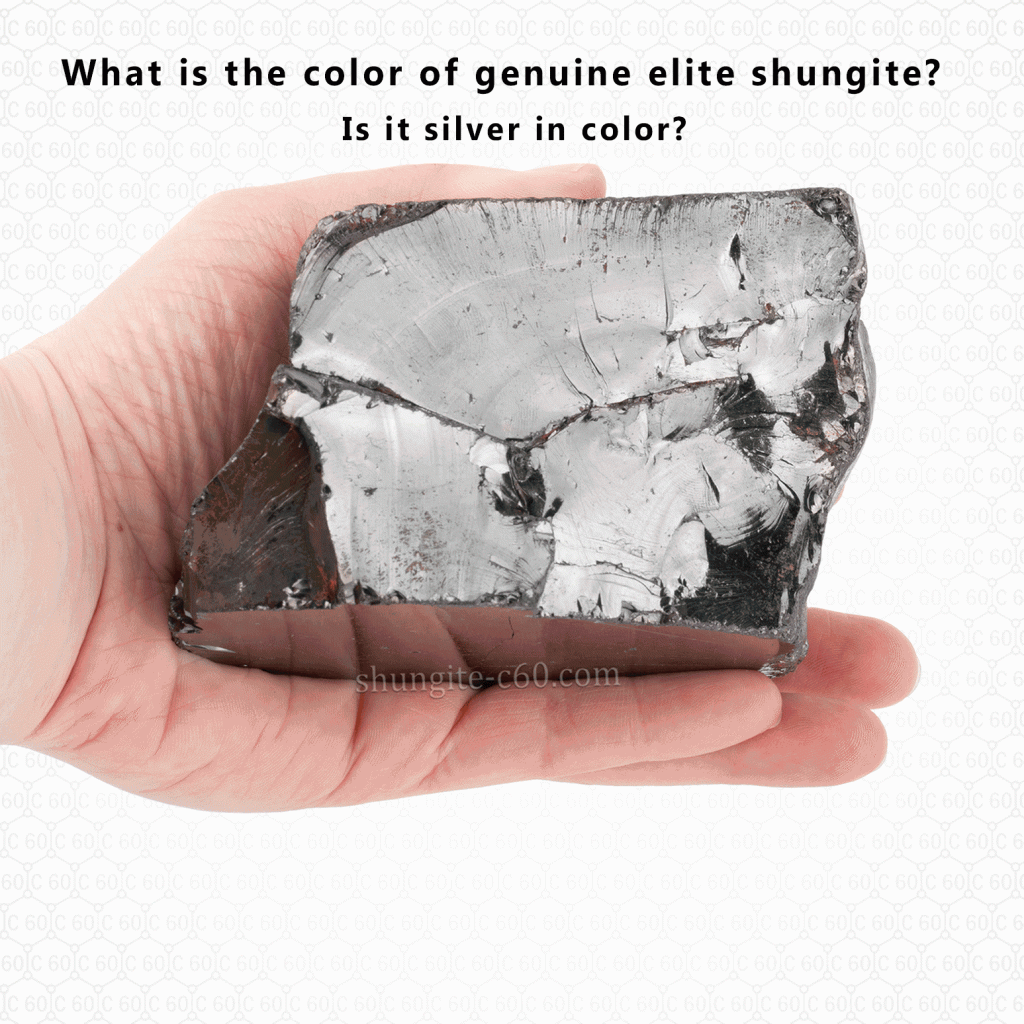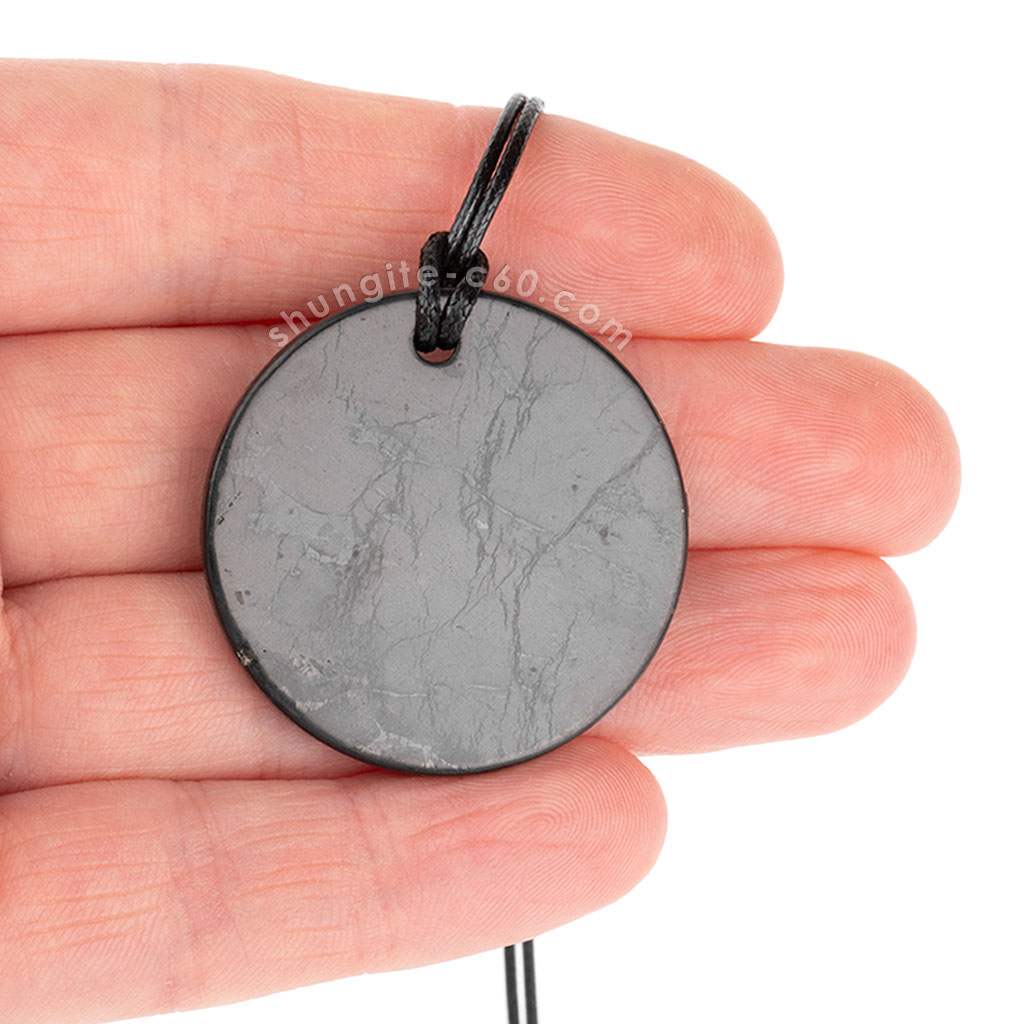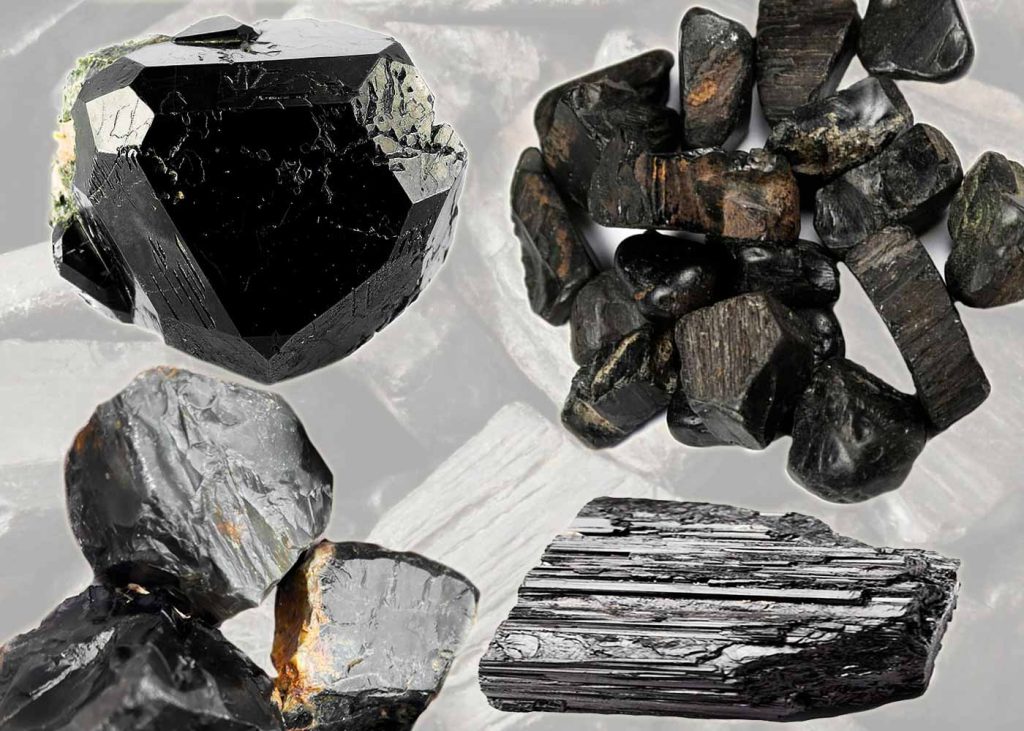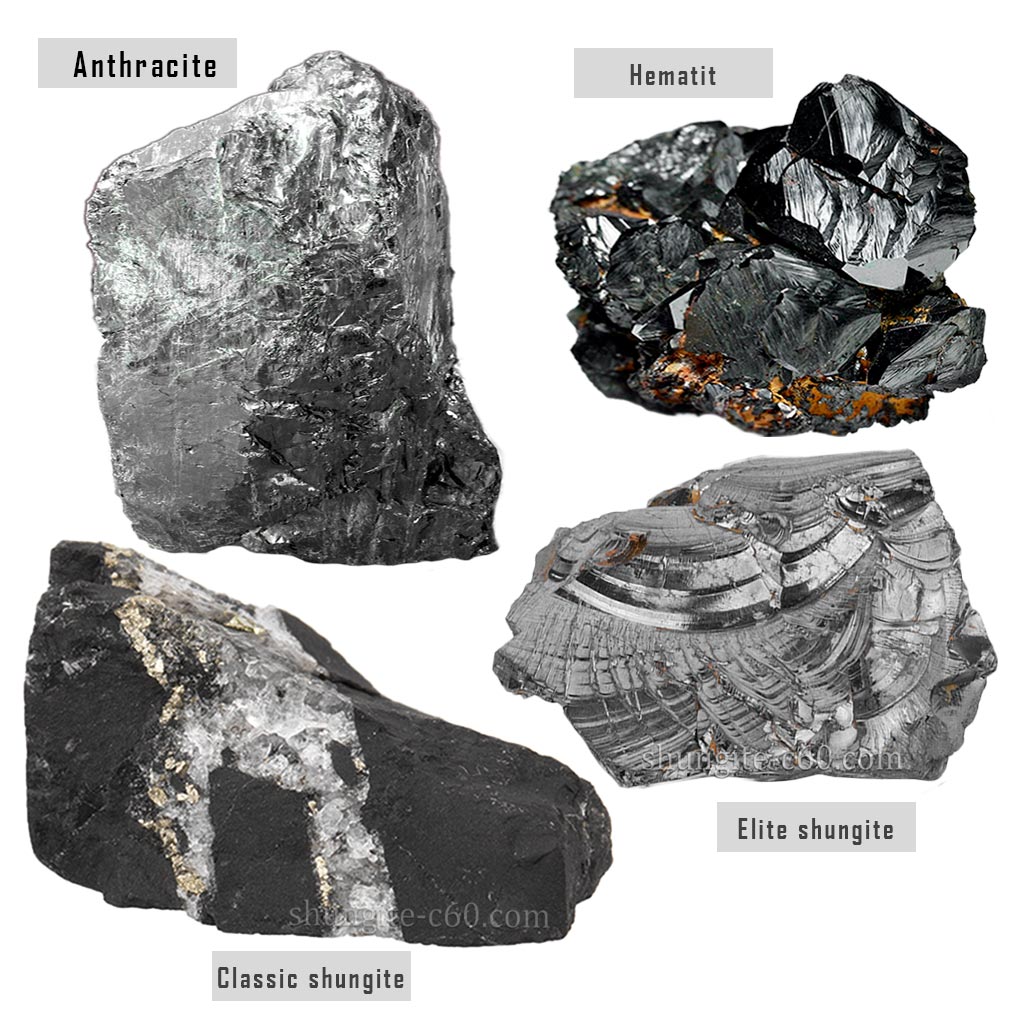The shungite with fullerenes are a real rare mineral of Precambrian age. The fullerene shungite was found only in one place on Earth, this is the Republic of Karelia in Russia. As a result of shungite studies, fullerenes in shungite stone c60 were discovered in 1992 by scientists from the University of Arizona, USA.
Scientists associate the presence of fullerenes in shungite with the special structure of shungite. The fact is that shungite is shungite carbon of a special allotropic form. In turn, this means that fullerenes, fullerites, and other nanoparticles can originate and exist in it.
Where found natural fullerenes shungite?
Natural shungite fullerenes were found in the highest carbon shungite rock. This rock is called shungite type one or elite shungite (trade name). The birth place of natural shungite fullerenes was found only in Karelia, Russia.
The whole land of Karelia is an amazing geological region, it has many outcrops of various rocks of shungite. These shungite rocks differ from each other depending on the amount of shungite carbon in their composition. And the highest carbon shungite rock in Karelia contains up to 98-99% carbon.
Discovery of fullerenes in Karelian shungite of the first type.
Fullerenes in solid form on Earth were discovered for the first time in shungite. Back in 1992, it was a sensational event. Scientists’ researchers discovered fullerenes in Karelian shungite stone 1 type.
This event took place at the University of Arizona in the USA. Fullerenes in shungite stone c60 were discovered by a team of scientists Buseck P.R., Tsipurski S.J., Hettich R. The source: “Fullerenes from the geological environment”, Buseck P.R., Tsipurski S.J., Hettich R. // Science. 1992. V. 257. P. 215–217 [1].
Fullerene properties
Fullerenes (or otherwise they are also called buckyball) are a closed molecular compound of carbon atoms, shaped like a ball. This is the only chemical compound that consists solely of only carbon atoms, which are interconnected in pentagons and hexagons.
This distinguishes fullerene from other carbon nanostructures, for example, from graphite or from diamond, which have foreign hydrogen atoms and others in the structure.
The buckyballs were discovered in 1985 by a group of scientists, for which they were awarded the Nobel Prize in Chemistry in 1996.
Fullerenes are the strongest antioxidants, due to which they are supposedly able to prolong the life of rats and annelids.
Also, fullerenes can be used in the creation of new drugs due to their antiallergic properties.
In addition, as found at the University of Paris, the fullerene molecules in olive oil can act as a reusable antioxidant.
And also, various derivatives of fullerenes have shown themselves to be effective agents in the treatment of human immunodeficiency virus.
In addition, fullerenes have the ability to have the property of superconductivity. Therefore, for example, scientists associate the unique ability of shungite to protect against the harmful effects of EMF radiation with the presence of fullerenes in it [5].
Disputes around fullerenes in shungite.
At the time of the discovery of fullerenes in shungite stone in 1992, scientists counted them in the amount of 1-10 ppm (0.0001-0.001%) of the mass of shungite. In those days, this figure was called surprisingly large.
Some authors tried to refute the presence of fullerenes in shungite stone c60. The fact is that they associated the appearance of fullerenes with the temperature effect on shungite. In addition, they called the appearance of fullerenes just an artifact.
After all, it is known that when the natural fullerene in shungite was first discovered, scientists used mass spectrometers, in which a sample of shungite was turned into vapor using laser evaporation.
Approximately the same way earlier scientists found fullerenes in graphite vapors. This happened in 1985 when researchers irradiated graphite with a laser. As a result of irradiation of graphite, vapor was released, in which mass spectra of fullerenes c60 and c70 were found for the first time.
Based on modern data on the structure of shungite, one can understand to some extent the opponents of fullerene shungite of that time. After all, as they found out in Russia, shungite consists of the smallest fragments of graphene oxide [2]. And graphene oxide, in turn, can assemble into fullerenes. Perhaps this explains the fact that when shungite carbon was exposed to temperature and even water, fullerenes appeared in such a large amount.
Fullerene in shungite is a scientifically proven fact.
However, fullerenes in shungite stone c60 are present on their own without temperature effects. This fact was confirmed by transmission electron microscopy. This method is based on the passage of an electron beam through a rock sample.
By means of high-resoluton transmission electron microscopy, both C(60) and C(70) fullerenes have been found in a, carbon-rich Precambrian rock from Russia The fullerenes were confirmed by Fourier transform mass spectrometry with both laser desorption and thermal desorption/electron-capture methods to verify that the fullerenes were indeed present in the geological sample and were not generated by the laser ionization event. The mass spectra were measured under conditions sufficient to resolve the (13)C/(12)C isotopic ratios for C(60) and C(70) and indicate that these ratios correspond to the normal range of isotopic values.
P R Buseck, S J Tsipursky, R Hettich : “Fullerenes from the geological environment”. This scientific work on shungite study was published in the journal “Science” in July 1992.
Also, from the scientific geological society confirm the presence of fullerenes in shungite in their article:
“Testing for fullerenes in geologic materials: Oklo carbonaceous substances, Karelian shungites, Sudbury Black Tuff: Comment and Reply: COMMENT.”
In addition, there are scientific studies showing the appearance of hydrated fullerene molecules after shungite infusion in water [3]. This explains the amazing properties of water infused with stones of shungite.
How to find fullerenes in shungite?
Shungite demonstrates amazing properties. Therefore, it is not surprising that shungite is of interest to many researchers. At the same time, scientists began to understand more about how shungite works, and this is a very complex mineral. And besides, more accurate methods for determining nano molecules in a substance have appeared. Such methods include, for example, spectroscopy.
By the way, it was with the help of spectroscopy that scientists discovered c60 fullerenes in space. Are there many or few of them? Or maybe they were there in sufficient numbers to be discovered. Also, in shungite. Fullerene molecules are almost imperceptible. But we see the result of their presence by the amazing properties of shungite, which people have noticed since ancient times.
Spectroscopy is a research method in which a molecule is detected by its reaction to infrared light. That is, infrared light passes through the material and is absorbed in the material. And at some point, the absorption of light increases. This happens at any particular wavelength.
In turn, this wavelength corresponds to a particular molecule. To confirm this fact, a lot of experimental information has been accumulated: there are special tables that relate absorption frequencies to the presence of certain molecular fragments in the sample.
Therefore, further we will talk in more detail about Russian research on shungite and what we know about the number of fullerenes for 2022.
Are there fullerenes in black shungite of the third type?
As you know, Buseck P.R. and the company for the first time found fullerenes in Karelian shungite of the first type (elite shungite, type 1 shungite, noble shungite or higher anthraxolite).
First of all, such success is due to the maximum amount of carbon in it, which is about 98-99%. At the same time, shungite carbon has the form of globules (multi-shell onions) with inclusions of fullerenes. Therefore, it was difficult not to notice them.
The question arises, are there fullerenes in other shungites, for example, in the most common black shungite?
Looking ahead, let’s say that now we understand that it was difficult to visually detect fullerene molecules in classic black rock of shungite for the following reasons.
- The content of alpha-quartz in the rock is about 60% and other inclusions of minerals.
- Polarity of shungite carbon.
- The ability to high aggregation of shungite carbon nanoparticles (nanoparticles quickly and actively gather into larger aggregates). In turn, this is due to their metastability and high activity.
Search for buckyballs in black shungite using infrared spectroscopy.
The question of the content of fullerenes in shungite stone c60 was also of interest to Vladimir Viktorovich Rodionov, Candidate of Physical and Mathematical Sciences. He revealed it in his scientific dissertation devoted to the EMF properties of this mineral: “Mechanisms of interaction of microwave radiation with nanostructured carbon-containing materials.”, Kursk 2015. [5]
He studied natural sample No. 1 of Zazhoginsky shungite with a carbon content of about 30%. And in order to avoid interference from other inclusions, he cleaned shungite carbon from permanent inclusions with hydrofluoric acid. At the same time, he brought the concentration of shungite carbon in sample No. 2 to 95-98%.
To register fullerenes in shungite, Rodionov used the method of infrared spectroscopy with Fourier transform and Raman (Raman Spectrum).
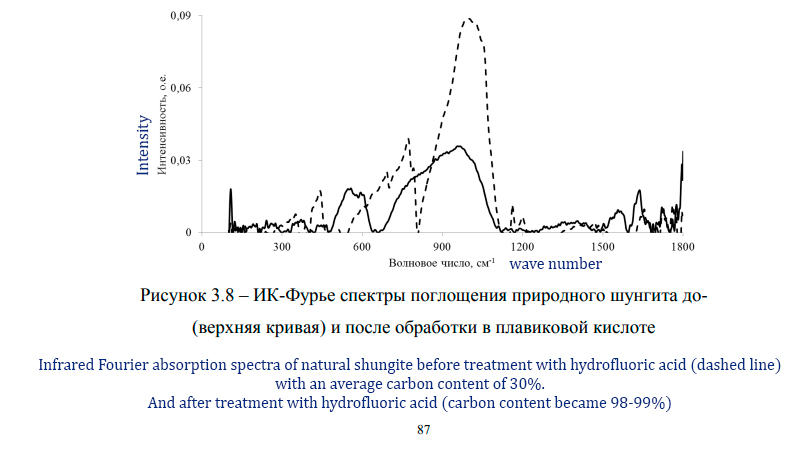
(upper curve) and after treatment in hydrofluoric acid. Absorption lines of C60 and C70 fullerenes in Karelian shungite.
Thus, using the method using the method of IR-Fourier spectroscopy, the researcher Rodionov found absorption bands in the original shungite mineral:
400-500, 600-800, 800-1100, 1300-1550 and 1150-1250, 1650-1700 cm -1
In other words, this means that these bands contain absorption lines of C60 fullerenes:
527, 577, 1183, 1428 cm -1.
And also there are lines of C70 fullerene:
458, 535, 642, 674, 795 and 1430 cm -1.
These results are consistent with the scientific work of Buseck, P.R. “In Geological fullerenes”, as well as with the study of V.V. Kovalevsky hyperfullerene carbonaceous matter in shungite rocks of the Onega structures [4].
What do fullerenes look like on a micro-cleavage of a shungite sample of the third type?
Also, the scientist Rodionov, in order to visually see the fullerenes in shungite stone c60, studied shungite chips of the third type (about 30% carbon) from the Zazhoginsky deposit in Karelia, Russia.
For this purpose, using a confocal microscope, I preliminarily selected areas of the surface of a chipped shungite stone with dimensions of 60 × 60 μm. Imagine this size is about the thickness of a human hair.
As a result of applying the mapping technique, he was able to detect dots with a diameter of 400 nm, in which lines of fullerenes 450 and 190 cm–1 appeared.
He then built a hyperspectral Raman distribution scan in this region, consisting of 900 Raman spectra (Raman Scattering Spectrum).
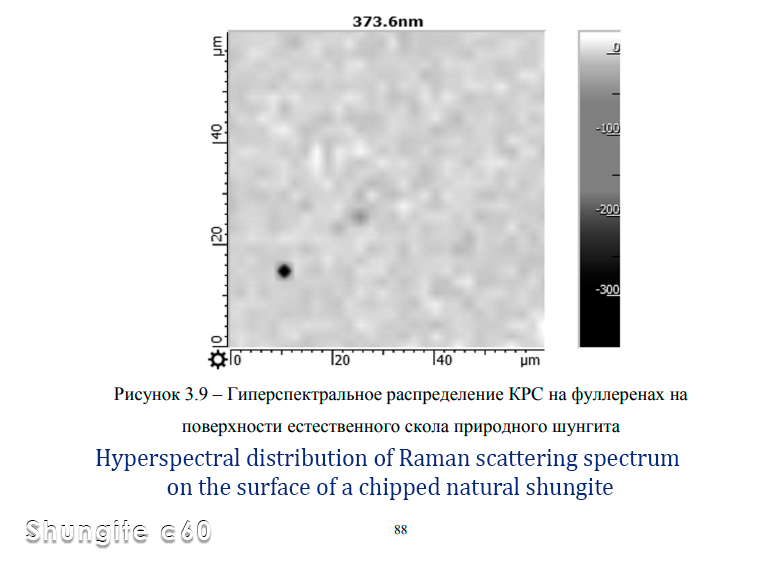
As a result, it turned out that the total content of such fullerene-containing dots reached 2% on the shungite surface. Scattering on fullerene formations was characterized by light areas in the scan.
Rodionov concludes that, apparently, it is the presence of natural aromatic carbon molecules in shungite. In turn, from which fullerenes are formed, they explain all the confirmed medical and biological properties of this natural mineral shungite.
Is there a difference between the carbon of elite shungite and classic shungite?
As we learned above, Rodionov made from sample No. 1 (natural Zazhogino shungite of the third type) sample with a schungite carbon content of 95-98%, using hydrofluoric acid. That is, he melted all the excess impurities in sample №1 to get a clean sample №2.
Further, in the process of X-ray diffraction phase analysis of the samples, the scientist Rodionov established a complete similarity between the carbon of the third type of shungite (Zazhogino) and the first type (elite shungite). That is, the shungite sample №2 had an identical phase composition as the elite shungite of the first type.
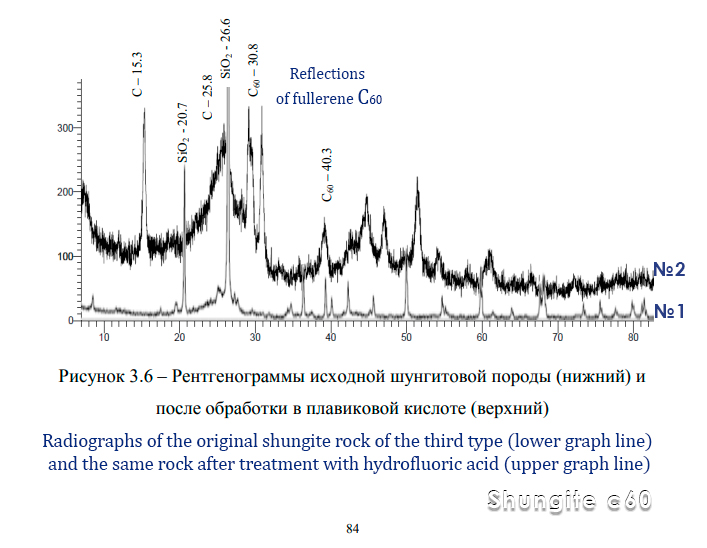
Based on the presented X-ray patterns, according to the phase composition of the original natural shungite, it was established that it belongs to type I shungites. In turn, this confirms the reflex in the vicinity of 20-80 degrees.
At the same time, we can clearly see the reflections of fullerene c60 on the x-ray plot.
What is the difference in the percentage of fullerenes between elite silver shungite and classic black?
So, since the carbon of shungites is identical and elite shungite consists of 98-99% carbon, and Zazhoginsky about 30%. It can be assumed that the amount of fullerenes in the black sample is approximately several times less than in elite shungite.
Also, this assumption echoes another work from 2000 by V.A. Reznikova and Yu.S. Polekhovsky. In this study, they conducted a comparative analysis of the values of density, porosity and intermolecular space in high-carbon shungite, graphite, glassy carbon and C60 fullerene.
As a result, the authors concluded that the content of fullerenes in the classic black shungite TYPE-3 from the Zazhogino deposit (sh-3) is 1%. While the amount of carbon in shungite TYPE-1 (sh-1) is 1.5-2%, depending on the extraction conditions.
Thus, the authors came to the conclusion that this is an industrially significant concentration of fullerenes for medical purposes in Karelian shungites. At the same time, the results of the study are consistent with the results of electrochemical extraction and extraction of fullerenes from shungites with polar solvents.
Approximately how many fullerene molecules are in black shungite of the third type?
Let us turn again to the scientific dissertation of the scientist Vladimir Rodionov, who studied shungite of the third type from the Zazhoginsky deposit. In his work, Vladimir Rodionov counted the number of fullerene molecules on a micro-cleavage of natural shungite rock with a size of 60×60 microns.
To do this, he used the radius of carbon formations in shungite: R ~ 2.5 nm. In turn, it was calculated in his work experimentally by the SAXS method (small-angle X-ray scattering) and calculated from the Scherer equation. Further, the scientist compared this radius with the characteristic radius of fullerene C60 – r = 0.357 nm.
And thus, using these data, he calculated the number (N) of the constituent fullerene molecules:
N = R3/r3 ~ 340,
(2.52.52.5= 15.625, 0.3570.3570.35= 0.045; 15.625/0.045 = ~ 347).
Thus, from Rodionov’s study, it follows that nanocluster carbon structures of the C60 fullerene type in shungite are located on natural shungite cleavages evenly over the entire surface (isotropically).
The amount of C60 fullerenes is about 2% on a sample of shungite from the Zazhoginsky deposit 60*60 µm in size (the thickness of a human hair), which is about 340 molecules.
The source:
- [1] P R Buseck, S J Tsipursky, R Hettich : “Fullerenes from the geological environment”, // Science. 1992. V. 257. P. 215–217, July 1992.
- [2] Amorphous shungite carbon is a natural environment for the formation of fullerenes, V.A. Reznikov, Yu.S. Polekhovsky St. Petersburg State University. Received March 6, 2000 Letters to ZhTF, 2000, vol. 26, no. 15.12 August, text of scientific work.
- [3] Rozhkova Natalya Nikolaevna, NANOCARBON OF SHUNGITES: structural and physico-chemical properties, activation mechanisms / Dissertations for the degree of Doctor of Chemical Sciences, specialty: 02.00.21 – solid state chemistry / St. Petersburg, 2013.
- [4] Kovalevsky, V.V. Hyperfullerene carbonaceous matter in shungite rocks of the Onega structure (Karelia) [text] / V.V. Kovalevsky, L.P. Galdobina, T.N. Lazareva, S.Yu. Chazhengina // Precambrian Minerageny: Proceedings of the All-Russian Conference. – Petrozavodsk, 2009. – S. 106-109.
- [5] Rodionov Vladimir Viktorovich: “Mechanisms of interaction of microwave radiation with nanostructured carbon-containing materials.” / DISSERTATION for the degree of Candidate of Physical and Mathematical Sciences / Specialty 01.04.07 – Condensed Matter Physics / Kursk – 2015.
